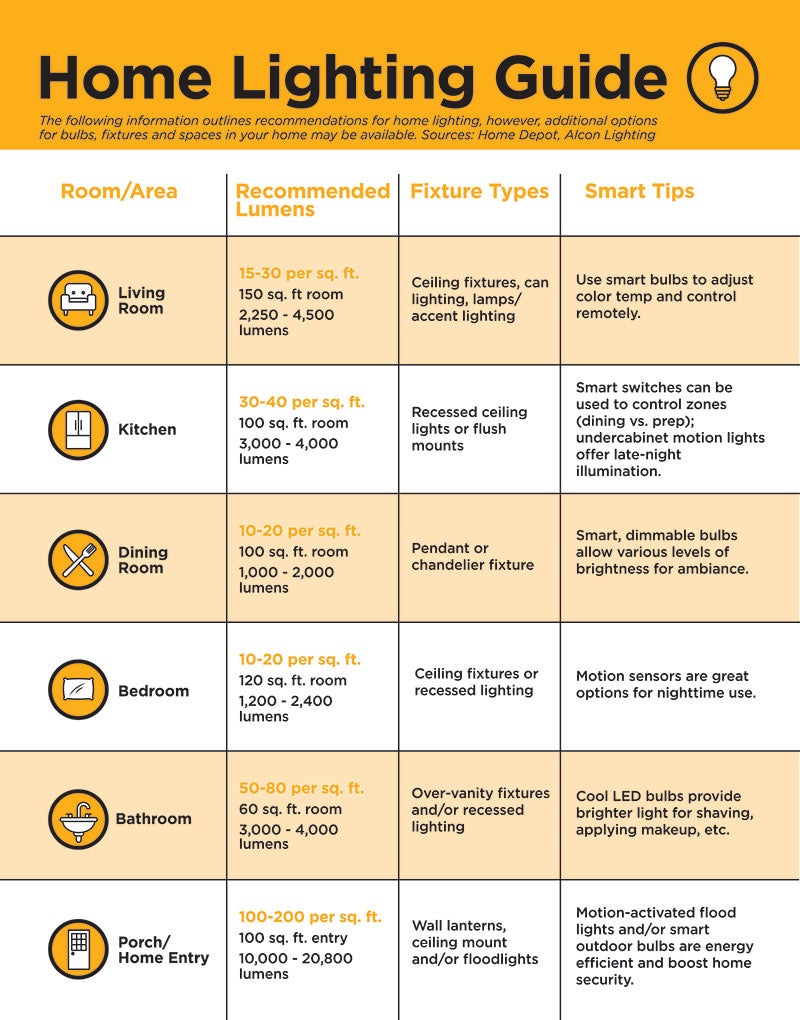Lighting is something most of us don’t think much about — until it’s wrong. Maybe the living room feels too dim for reading, or the kitchen lights cast an odd yellow glow. We often grab whatever bulb or fixture looks good without considering how it will actually perform in the space. But with a little planning, you can make your home brighter, cozier and more energy efficient.
Watts vs. Lumens
When you’re shopping for lightbulbs, it’s easy to focus on watts, but watts only measure how much energy a bulb uses. When it comes to brightness, what really matters is the lumen count. Lumens measure the actual light output. For example, an 800-lumen bulb emits approximately the same amount of light as a traditional 60-watt incandescent bulb. (You’ve likely replaced all incandescent bulbs with long-lasting, energy-efficient LEDs, but if not –– it’s time to make the switch!)
A helpful rule of thumb: Higher lumens mean brighter light, while lower watts mean less energy consumed. Remember to check wattage ratings for fixtures and only install bulbs that meet the fixture’s wattage safety requirements.
Color Temperature and Consistency
Lightbulbs also vary in color temperature, which ranges from warm yellow to cool white or even bluish tones. This detail often gets overlooked until you replace one bulb and notice the new light doesn’t quite match the others. If mismatched tones drive you crazy, consider buying and installing bulbs of the same brand and wattage in a room at the same time. That way, the look stays consistent, and you won’t be stuck hunting for a perfect match later.
Dimmers and Switches
Installing dimmers instead of standard on/off switches can be a game changer. Dimmers give you more control over brightness, help save energy and create a more comfortable atmosphere. Not all bulbs are dimmable, so double-check labels before buying.
While you’re thinking about switches, consider whether you have enough of them — and in the right places. A light you can only turn off from one end of a hallway quickly becomes annoying. For new installations or upgrades, it’s best to hire a licensed electrician to ensure everything is wired safely and efficiently.
Fixtures: Form Meets Function
Bulbs are only part of the equation — fixtures matter too. Each type serves a purpose. Ambient lighting, like sconces or glass-covered ceiling fixtures, provides general illumination. Task lighting, like pendants, desk lamps or track lighting, focuses light where you need it most.
When choosing a fixture, think beyond looks. Ask yourself: Does this light provide the right amount of brightness for the space? A beautiful chandelier might look perfect over the dining table but it leaves the rest of the room too dim. Alternatively, an oversized fixture could flood the room with more light than you need, wasting both energy and money.
Smart Lighting: Energy Efficiency Meets Convenience
Smart lighting adds another layer of control for illuminating your home. But the real magic is convenience. With smart bulbs, you can adjust brightness, set schedules or even change colors — all from your phone or a voice assistant like Alexa or Google Assistant. Want the lights to dim automatically for movie night? Or to turn on before you get home? Smart bulbs make it easy.
Smart lighting also lets you personalize your space. You can go classic with warm white tones or experiment with colors to set the mood — anything from a soft glow for winding down to vibrant hues for a party. Remember, smart bulbs still rely on power from your wall switch, which needs to stay in the “on” position for remote controls to work. If you prefer using a physical switch, consider pairing smart bulbs with a smart light switch. Many of today’s smart switches also feature motion detectors, adding an extra level of efficiency and convenience.
Good lighting doesn’t just make your home look better — it makes it feel better too. With a little planning, you can create spaces that are welcoming, functional and energy efficient. Whether you stick to traditional bulbs and fixtures or explore the flexibility of smart lighting, thoughtful choices today will brighten your home for years to come.

